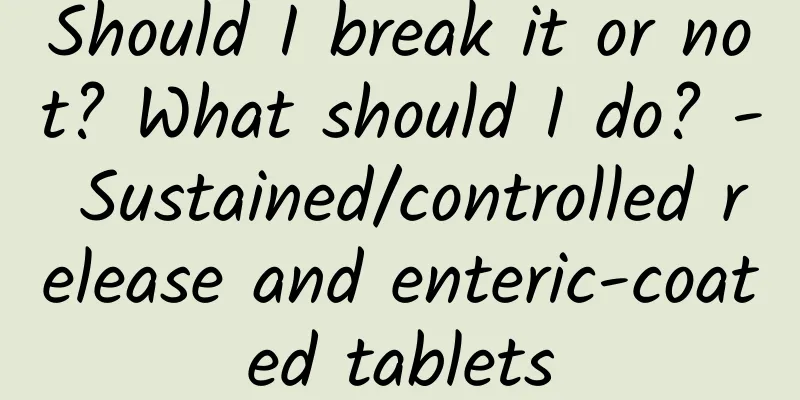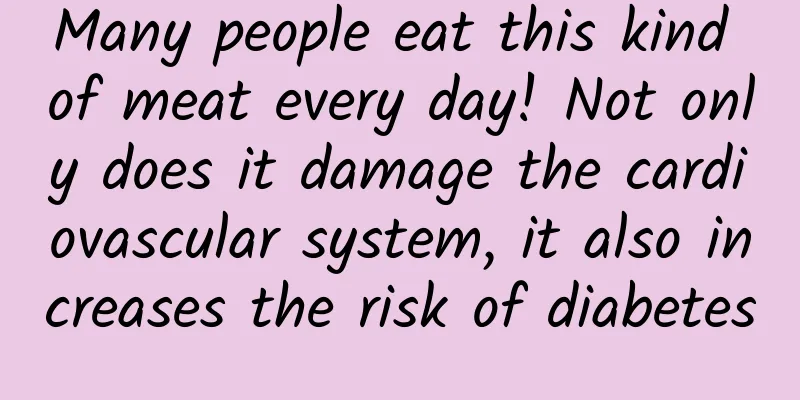Should I break it or not? What should I do? - Sustained/controlled release and enteric-coated tablets

|
I often hear some patients complain that the tablets are too big and difficult to swallow, so it is better to break them up or chew them. But is this really okay? In fact, except for chewable tablets, chewing medicines is generally not recommended. So, is it okay to break the tablets up and take them? Let's take sustained/controlled release and enteric-coated tablets as examples to talk about how to take medicines correctly. 1. Sustained release? Controlled release? One word makes a big difference Sustained-release preparations refer to oral drugs that are released at a slow, non-constant rate in a specified solvent, while controlled-release preparations refer to oral drugs that are released at a slow, non-constant rate in a specified solvent. Both can prolong the duration of drug action, reduce the number of medications, keep the drug concentration in the body relatively stable, and reduce adverse reactions caused by excessive doses of drugs in a short period of time. However, the release rate of the former is easily affected by external environmental factors such as pH, while the release rate of the latter is more constant. 2. Can sustained-release tablets and enteric-coated tablets be crushed or broken apart? All sustained-release tablets and enteric-coated tablets cannot be crushed before taking, but a small number of them can be broken apart and taken. During the production process, sustained-release tablets use special preparation processes to delay or quantitatively release drugs. Common types include skeleton-type, coating-type, and osmotic pump-type. These special dosage forms are designed to prolong the efficacy of the drug, and the drug content is usually greater than that of ordinary preparations. Once the special dosage form is destroyed, excessive drugs will be released rapidly in a short period of time, which may cause a sudden increase in drug concentration in the body, resulting in severe drug use or increased adverse reactions. For example, the dissolution principle of nifedipine controlled-release tablets, a commonly used drug for the treatment of hypertension, is to release the active drug ingredients by osmotic pressure difference. Once it is broken or crushed, the controlled-release effect disappears, and the drug that exceeds the conventional dose is released in a short period of time, which is likely to cause adverse reactions such as low blood pressure. Similarly, enteric-coated tablets also refer to tablets that use special coating materials and preparation processes to make the drug dissolve in intestinal fluid instead of in gastric juice. Destroying its special structure will cause the drug activity to be destroyed by gastric acid, lose its efficacy, or make it impossible to release the drug in a targeted manner, affecting the targeted local effect; it may also damage the stomach, causing or aggravating stomach diseases. However, a few sustained-release and enteric-coated tablets use a multi-unit microcapsule system, such as metoprolol succinate sustained-release tablets. Each microcapsule is an independent storage unit and can be broken apart and taken without affecting the efficacy, but the microcapsule structure should not be chewed or crushed. Esomeprazole enteric-coated tablets contain multiple enteric-coated microcapsules. For patients with dysphagia, the tablets can be dissolved in half a cup of water (carbonate-free water) and taken after complete dissolution, but the microcapsule structure should not be chewed or crushed. 3. What should you do for special groups of people? For some special groups such as the elderly, infants, and those with impaired liver and kidney function, the medicine must be broken apart because of difficulty in swallowing or the need for special doses. Before taking the medicine, you should consult a doctor and pharmacist. Under normal circumstances, sustained-release tablets have scores on the surface and can be carefully broken apart along the scores for taking. Do not grind, chew, or cut the tablets at will. For ordinary tablets, you still need to be cautious when cutting the tablets. Do not use tools such as kitchen knives and scissors to cut the tablets at will, otherwise it may cause too much debris during the cutting and loss of effective drugs. At the same time, the doses of the cut tablets may also be unequal, resulting in increased or decreased efficacy. Especially for drugs with a narrow therapeutic range such as digoxin and theophylline, their therapeutic doses are close to the toxic doses, and cutting such tablets requires more caution. Therefore, if the tablets must be cut, it is recommended to use a special tablet splitter to reduce the reduction of efficacy or adverse reactions caused by inaccurate doses. |
<<: I am an epileptic and want to have a child. Can I stop taking medication?
>>: When did the history of gluten begin? How to cook gluten
Recommend
What can a female dog eat after giving birth to puppies? How long should a female dog be sterilized?
Dogs are just like humans. After giving birth to ...
What to do if you have difficulty getting pregnant due to cold uterus
Uterine cold is a common disease among women, and...
Will I have breast pain during early pregnancy?
When a woman is just pregnant, many changes will ...
What to do if you have back pain at 39 weeks of pregnancy
During the pregnancy, the pregnant woman's bo...
Is it better to use tampons or sanitary napkins?
Women's physiology is quite special. They hav...
What are the symptoms of anemia during pregnancy?
The main symptoms of anemia in pregnant women dur...
What are the causes of dull pain in the lower left abdomen during ovulation?
The ovulation period is the period with the highe...
What are the benefits of drinking snake wine for women?
There are various types of wine. If you want to t...
4 weeks pregnant progesterone
After pregnancy, you must test your progesterone ...
Can identical twins be boy-girl twins?
First of all, we need to understand how identical...
Young stroke, how far are we from it?
Author: He Yanbo, deputy chief physician of Beiji...
Can virgins also suffer from gynecological inflammation?
For women who have had sex, the probability of de...
Millward Brown: Mobile advertising is not liked, but it seems to be effective
Smartphone or tablet users may like their devices...
Diabetic Guide | Overcoming all difficulties to form a group and debut, oral hypoglycemic drugs show their super strength!
Author: Zhang Xuan, Chief Pharmacist, Zhongshan H...
How to prevent eye inflammation after swimming?
With the coming of summer, swimming has become th...









